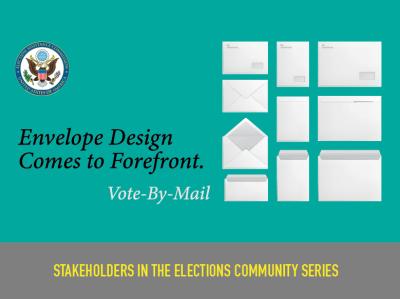
EAC staff enjoys learning from and hearing about the experiences of stakeholders in the election community. A recent discussion with Drew Davies, owner and design director of Oxide Design Co., provides insight that may be of interest to those curious about the design aspect of vote by mail materials. Voting by mail increased by more than 4,000,000 voters between the 2010 and 2016 general elections and this practice appears to be increasing even at the jurisdiction-level throughout the country. I’d like to share Mr. Davies’ experience with the design of envelopes for the California system.
By Drew Davies
 Under the Voter’s Choice Act, California is transitioning to a system in which all voters will receive their ballots by mail. Voters can return their ballots by mail or dropbox, or they can still choose to vote in person instead.
Under the Voter’s Choice Act, California is transitioning to a system in which all voters will receive their ballots by mail. Voters can return their ballots by mail or dropbox, or they can still choose to vote in person instead.
In 2018, Oxide Design Co. and the Center for Civic Design came on board to help the Future of California Elections, a collaborative initiative that includes election officials, to prepare one of the most crucial pieces in switching to a statewide vote-by-mail (VBM) distribution system: the envelopes.
Oxide Design Co. and the Center for Civic Design’s role in this process involved designing both outgoing and return envelopes. Outgoing envelopes are sent by the county to the voter, containing the ballot and the return envelope. Return envelopes are how the voter returns their ballot to the county if they don’t vote in person.
The envelopes needed to be clean, with clear instructions, and still obviously government-issued. One of the design challenges for this project was developing a set of best practices to be interpreted by each individual county. Some of the counties design their own ballots and envelopes in-house, while others hire an election vendor. Additionally, each print vendor has its own different parameters for the exact dimensions of an envelope that it can print. So, best practices needed to establish consistent rules, yet be flexible enough for diverse implementation.
The new design will make it easier for voters to vote by mail, given affordable and robust election administration. The redesigned envelopes make it easier for voters to recognize and return their ballot accurately, through improved usability and plain language instructions. The design structure also allows for optional inclusion of a second language, to meet Voting Rights Act language access requirements.
The visual anchor of the design is a color bar on the envelopes that help voters and election administrators identify different types of ballot envelopes easily. The colors are also helpful for the USPS, because they help distinguish envelopes on their way to voters from those returning to the elections office. The color wraps around the edge of the envelope, so it is visible in a stack of mailers, making them easy to identify at the postal facility.
VBM has the potential to help more Americans to vote. So long as everything about it is straightforward and clear, perhaps, we will be able to eliminate some of the many barriers to the voting process. Better still, VBM is possibly an affordable option for election administrators, and one that might help reduce errors and ease counting.
Statewide implementation of VBM envelopes has allowed California to be efficient as the State developed one set of best practices that all counties can use. The consistent look makes it easier and more efficient to create streamlined voter education campaigns across county lines. And the U.S. Postal Service has a simpler time processing the ballots. We’re excited to continue to see how California discovers and solves challenges with implementing a statewide vote-by-mail system.
Whether any given state or county has moved entirely to vote-by-mail, or allows absentee balloting only in limited circumstances, well-designed VBM envelopes can dramatically ease the process for both voters and election administrators.
Additional resources:
Design Documentation for Vote-By-Mail Envelopes, Center for Civic Design
Helping vote-by-mail ballots make their way to the voter and back again, Center for Civic Design
Drew Davies is the founder and designer of Oxide Design Co.

